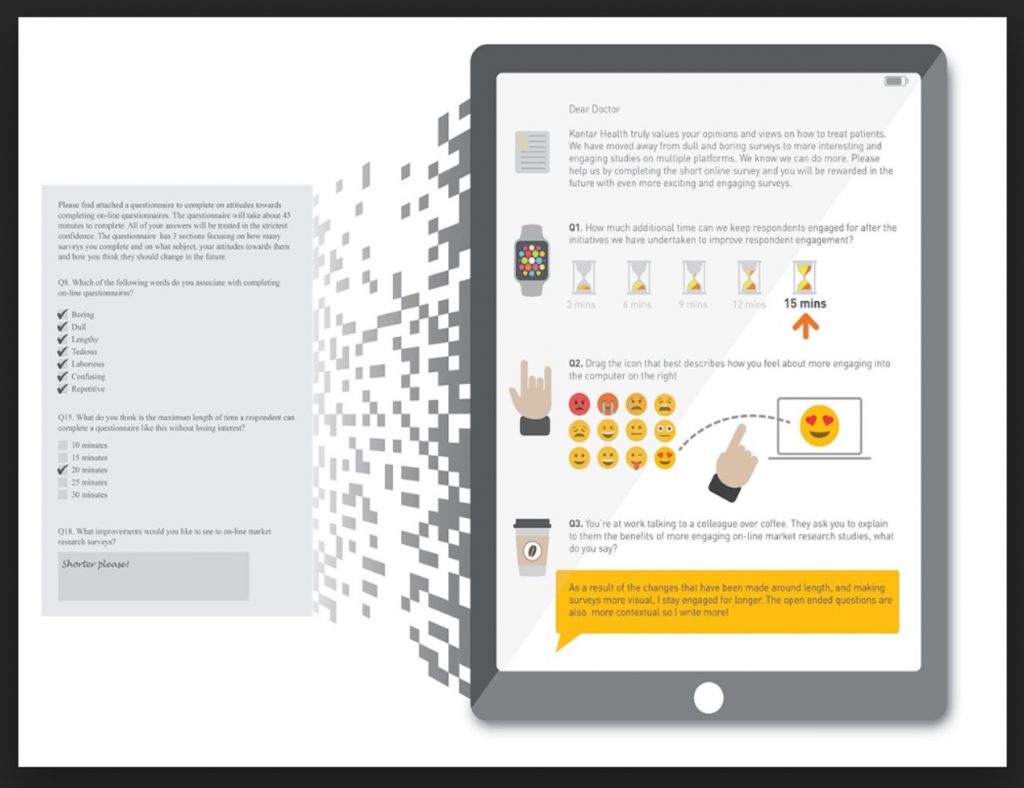As Albert Einstein once said, “Insanity is doing the same thing over and over again, but expecting different results”.
It’s no secret that fewer physicians are willing to participate in market research surveys today. The decline in survey engagement among physicians and their unwillingness to engage in surveys to provide full, meaningful responses is a growing problem for the entire research community and one of particular detriment to healthcare research where quality findings drive life-changing decisions.
For the wellbeing of our industry, we need to think strategically and fast about how to optimize survey design to improve engagement and response rates. A few icons here and there to pretty up questionnaires is not going to cut it. Buzz words such as survey
gamification and
de-borification, which have been bandied about in the industry over the last few years, show promise, but companies haven’t displayed any concrete examples of successful initiatives – until now!
Kantar Health has fully embraced the task of improving respondent engagement in our surveys and we’re proud to talk about two recent successes – a UK study with payers in the respiratory arena and an international study with oncologists. In both cases, we operated with one simple objective – make participation in market research surveys a more memorable and positive experience for each participant, as we strongly believe that participants will give the best of themselves when they feel they’re personally contributing to the improvement of something rather than just being counted as a number.
How to improve survey engagement and response rates
- Irresistible Invitation Letters – Our first step was to work with our fieldwork partners to develop invitation letters that are more attractive and raise interest right from the beginning. We focused on three elements: attractiveness, using key facts for capturing physician interest; brevity, using a minimal number of words to make our points short and sweet; and clarity, focusing on being clear for the required effort and remuneration.
- Creative Open-Ended Questions – We placed special attention on creative, open-ended questions and applied questioning methods typically used in qualitative research. Through gamification elements that doubled the word counts we also we created scenarios and solicited input that produced better engagement with deeper and more meaningful contribution. For example, we placed the physician in a situation, i.e., “To begin with, we’d like you to imagine that you are giving a lecture to your peers about how to prescribe drug x for patients with disease y. In what typical profile of patient, if any, would you suggest an 800mg initiation dose?”.’
- Shorter, Focused Surveys – We then worked to make questionnaires shorter and more relevant to the respondents. By only asking questions on issues important to respondents, and avoiding questions on products that respondents are aware of but have not used, we achieved more focused surveys with more impactful responses.
- Iconography that Makes Answering Quick and Fun – Finally, we increased our use of visual triggers or iconography. Through enhanced and creative use of icons, images, sliders and dynamic grids, we achieved a better emotional connection, which increased attention from respondents and produced a higher quality of data.
.

As with all Kantar Health studies, we track respondent experience through questions at the end of our surveys. These measures allow us to ascertain level of enjoyment, clarity of the questionnaire design, level of personal contribution, and total amount of time actually spent completing the survey. Satisfaction metrics for our redesigned market research survey have increased by 10 percent, with more than 80 percent saying the online surveys were “enjoyable” or “very enjoyable.” In fact, our best survey score to date for enjoyment has been 96%, with one respondent saying it was the “best survey I participated in ever”, and our team is working hard to score our first 100% enjoyment rating! In addition, the open-end re-design has improved the richness of responses, and we believe that, over time, doctors will gain more experience and become even more comfortable with this new style of questioning.
The success of our redesigned market research surveys has not gone without notice at Kantar Health and the greater group of WPP companies. We are recent winners of a
WPPed Cream Award – Prescription to Healthcare Professionals 2016. The honor, given for Kantar Health’s innovative and engaging survey design aimed to reawaken healthcare providers’ interest in market research, was awarded in the category of communication to healthcare professionals
. The
WPPed Cream Awards recognize the very best work produced by WPP companies in all disciplines across nine categories. All WPP agencies have the opportunity to compete and be recognized for outstanding work that has provided growth and brand value to clients.
We are energized by our success and we’ll continue to develop new ideas and use new survey tools to create even more engaging questionnaires
. Our future plans include providing learning opportunities to our survey respondents, as feedback from respondents has indicated this increases their enjoyment even more.
Additionally, we are also excited about our partnership with the GRBN Participant Engagement Initiative believing that together we’ll be successful in advancing and promoting the evolving role and importance of market research to industry.
 Richard Goosey
Richard Goosey
Chief Methodologist, Marketing Insights
Kantar Health
 As with all Kantar Health studies, we track respondent experience through questions at the end of our surveys. These measures allow us to ascertain level of enjoyment, clarity of the questionnaire design, level of personal contribution, and total amount of time actually spent completing the survey. Satisfaction metrics for our redesigned market research survey have increased by 10 percent, with more than 80 percent saying the online surveys were “enjoyable” or “very enjoyable.” In fact, our best survey score to date for enjoyment has been 96%, with one respondent saying it was the “best survey I participated in ever”, and our team is working hard to score our first 100% enjoyment rating! In addition, the open-end re-design has improved the richness of responses, and we believe that, over time, doctors will gain more experience and become even more comfortable with this new style of questioning.
The success of our redesigned market research surveys has not gone without notice at Kantar Health and the greater group of WPP companies. We are recent winners of a WPPed Cream Award – Prescription to Healthcare Professionals 2016. The honor, given for Kantar Health’s innovative and engaging survey design aimed to reawaken healthcare providers’ interest in market research, was awarded in the category of communication to healthcare professionals. The WPPed Cream Awards recognize the very best work produced by WPP companies in all disciplines across nine categories. All WPP agencies have the opportunity to compete and be recognized for outstanding work that has provided growth and brand value to clients.
We are energized by our success and we’ll continue to develop new ideas and use new survey tools to create even more engaging questionnaires. Our future plans include providing learning opportunities to our survey respondents, as feedback from respondents has indicated this increases their enjoyment even more.
Additionally, we are also excited about our partnership with the GRBN Participant Engagement Initiative believing that together we’ll be successful in advancing and promoting the evolving role and importance of market research to industry.
As with all Kantar Health studies, we track respondent experience through questions at the end of our surveys. These measures allow us to ascertain level of enjoyment, clarity of the questionnaire design, level of personal contribution, and total amount of time actually spent completing the survey. Satisfaction metrics for our redesigned market research survey have increased by 10 percent, with more than 80 percent saying the online surveys were “enjoyable” or “very enjoyable.” In fact, our best survey score to date for enjoyment has been 96%, with one respondent saying it was the “best survey I participated in ever”, and our team is working hard to score our first 100% enjoyment rating! In addition, the open-end re-design has improved the richness of responses, and we believe that, over time, doctors will gain more experience and become even more comfortable with this new style of questioning.
The success of our redesigned market research surveys has not gone without notice at Kantar Health and the greater group of WPP companies. We are recent winners of a WPPed Cream Award – Prescription to Healthcare Professionals 2016. The honor, given for Kantar Health’s innovative and engaging survey design aimed to reawaken healthcare providers’ interest in market research, was awarded in the category of communication to healthcare professionals. The WPPed Cream Awards recognize the very best work produced by WPP companies in all disciplines across nine categories. All WPP agencies have the opportunity to compete and be recognized for outstanding work that has provided growth and brand value to clients.
We are energized by our success and we’ll continue to develop new ideas and use new survey tools to create even more engaging questionnaires. Our future plans include providing learning opportunities to our survey respondents, as feedback from respondents has indicated this increases their enjoyment even more.
Additionally, we are also excited about our partnership with the GRBN Participant Engagement Initiative believing that together we’ll be successful in advancing and promoting the evolving role and importance of market research to industry.
 Richard Goosey
Chief Methodologist, Marketing Insights
Kantar Health
Richard Goosey
Chief Methodologist, Marketing Insights
Kantar Health 





